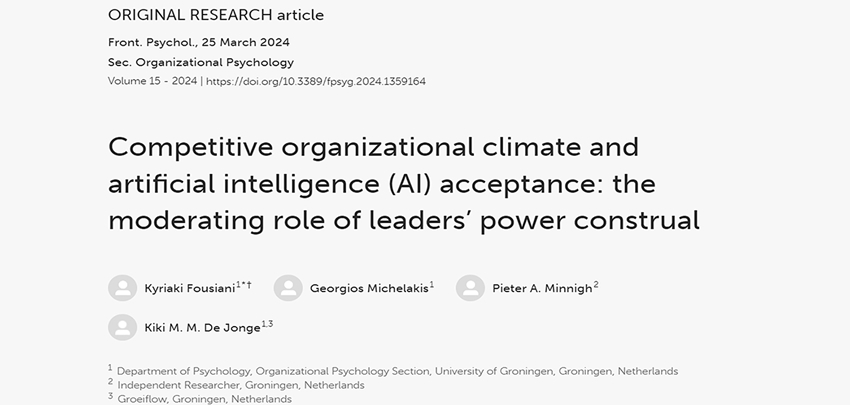Competitive organizational climate and artificial intelligence (AI) acceptance: the moderating role of leaders’ power construal

Artificial intelligence (AI) stands at the forefront of the fourth industrial revolution, where organizations are strategically integrating it as a vital tool to address a diverse range of daily management and work-related challenges. Yet, despite the advantages of AI, employees frequently perceive AI as a double-edged sword with unintended consequences. Kyriaki Fousiani and colleagues investigated how work climate influences employee attitudes toward AI and actual AI use. They found that a competitive climate increases AI acceptance over time (i.e., positive attitude and use), but only when leaders use their power as a responsibility to serve their team rather than as an opportunity to promote their agenda. The results of this study underscore the organizational factors that are required in order for employees to shape favorable attitudes towards AI and actually use AI at work.
Abstract:
Introduction: The incorporation of Artificial Intelligence (AI) in organizations is pivotal to deal with work-related tasks and challenges effectively, yet little is known about the organizational factors that influence AI acceptance (i.e., employee favorable AI attitudes and AI use). To address this limitation in the literature and provide insight into the organizational antecedents influencing AI acceptance, this research investigated the relationship between competitive organizational climate and AI acceptance among employees. Moreover, given the critical role of a leader in employee attitude and behavior, we examined the moderating role of leaders’ power construal as responsibility or as opportunity in this relationship.
Methods: Study 1 was a three-wave field study among employees (N = 237, Mage = 38.28) working in various organizations in the UK. The study measured employees’ perception of a competitive organizational climate at Time 1, leaders’ power construal (as perceived by employees) at Time 2, and employee attitudes towards AI and their actual use of AI in the workplace at Times 2 and 3. Study 2 was a 2 (climate: highly competitive vs. low competitive) by 2 (power construal: responsibility vs. opportunity) experiment among employee participants (N = 150, Mage = 37.50).
Results: Study 1 demonstrated a positive relationship between competitive climate and employee AI use over time. Furthermore, both studies revealed an interaction between competitive climate and leader’s power construal in the prediction of employee AI acceptance: In Study 1, competitive climate was negatively related to AI acceptance over time when leaders construed power as opportunity. In Study 2 competitive climate was positively related to AI acceptance when leaders construed power as responsibility rather than as opportunity.
Discussion: These results underscore the organizational factors that are required in order for employees to shape favorable attitudes towards AI and actually use AI at work. Importantly, this research expands the limited body of literature on AI integration in organizations.
You can read the full paper here.

